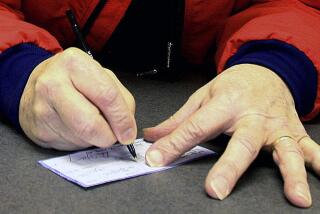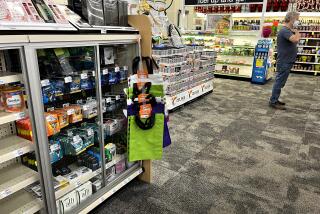Amount of Check Fraud Rose Substantially in ’93 : Crime: ‘The banking system is under attack,’ authorities say. Desktop publishing is one reason.
- Share via
WASHINGTON — Thieves, often working in gangs using relatively inexpensive equipment, passed twice as many bogus checks last year as in 1991, costing banks $815 million.
“The banking system is under attack by organized crime,” warned Bruce Brett, chairman of the American Bankers Assn.’s check fraud task force.
Brett told reporters Wednesday that the number of bogus checks jumped to 1.3 million in 1993 from 536,000 two years earlier, when counterfeiting cost banks $247 million.
But Brett said the ABA figures understate the problem because they do not include losses by other financial institutions, such as savings and loans and credit unions.
And the $815 million in losses in 1993 probably would have doubled if failed attempts to pass fraudulent checks had been successful, he said.
Ronald Dick, chief of the FBI’s Financial Institution Fraud Unit, concurred, saying the “serious and growing problem” of check fraud has become the “crime of the ‘90s.”
Sixty percent of the 8,000 complaints received by the FBI from financial institutions in September and October involved bogus checks, he said at the news conference.
Brett said the proliferation of desktop publishing has made computer equipment and software used in check forgery more affordable. In addition, laser products are widely available for duplicating and printing, he said.
Meanwhile, a Washington organization representing major U.S. and Canadian check-printing companies announced voluntary guidelines designed to fight check fraud.
The Financial Stationers Assn. said the guidelines include the use of tiny words and letters on the check front that, without a microscope, appear to be a solid line.
The guidelines also recommend printing a drawing of a padlock to the right of the word dollar on the front of a check to indicate it contains security features, and a warning box on the back listing the features.
The ABA survey of 309 representative banks found financial institutions in the Northeast and West to be among the hardest hit, although most participants experienced losses.
The survey found the average fraudulent check totaled $643 in 1993, down from $1,058 in 1991. That relatively small amount, together with the volume of checks, made fraud more difficult to detect.
Brett said one of the most common forms of organized check fraud involves gangs that acquire a genuine payroll check and reproduce it. They then manufacture fake identification cards to match the payee’s name and send cohorts to cash the bogus instruments at banks.
More to Read
Sign up for Essential California
The most important California stories and recommendations in your inbox every morning.
You may occasionally receive promotional content from the Los Angeles Times.









